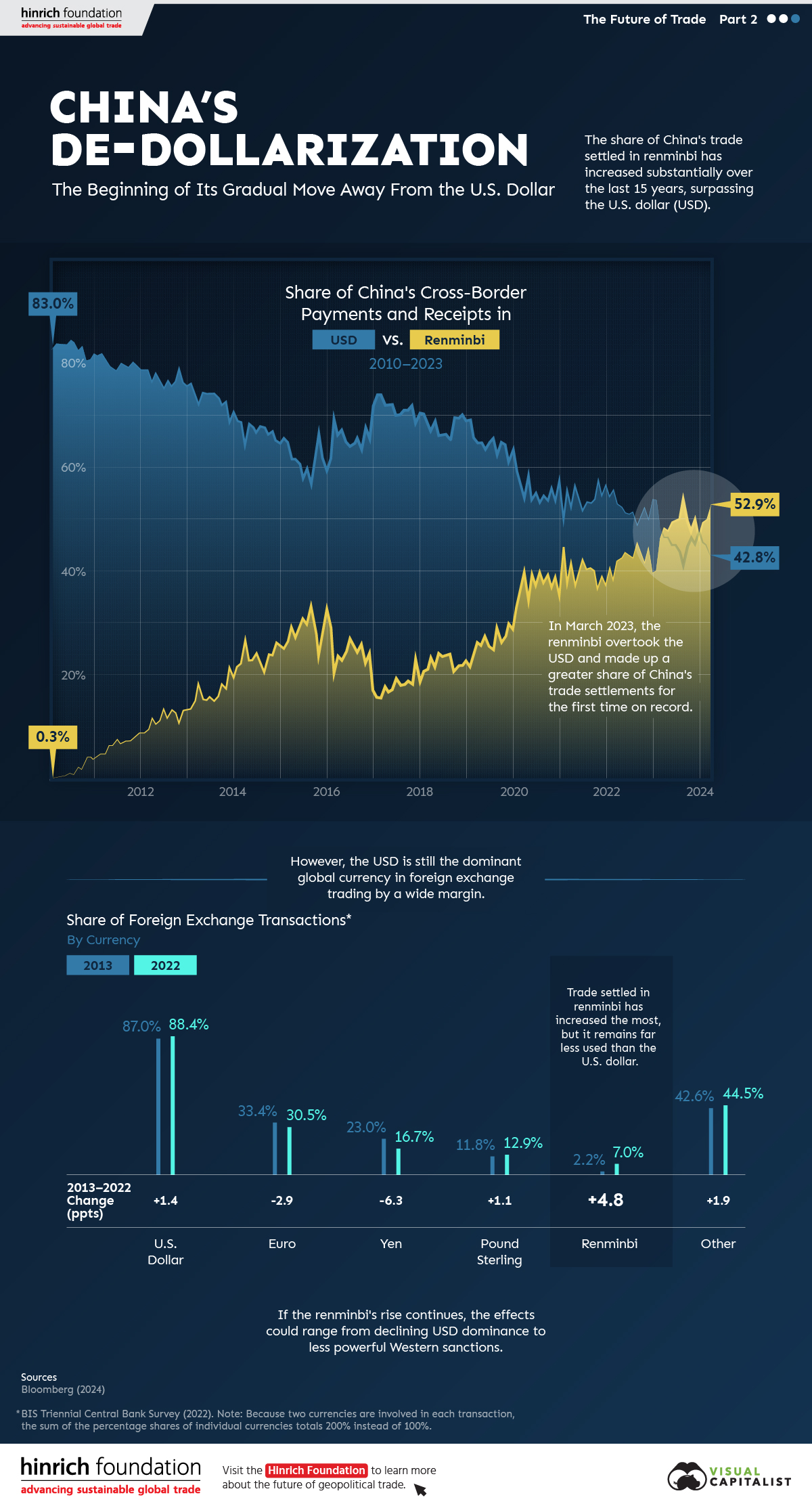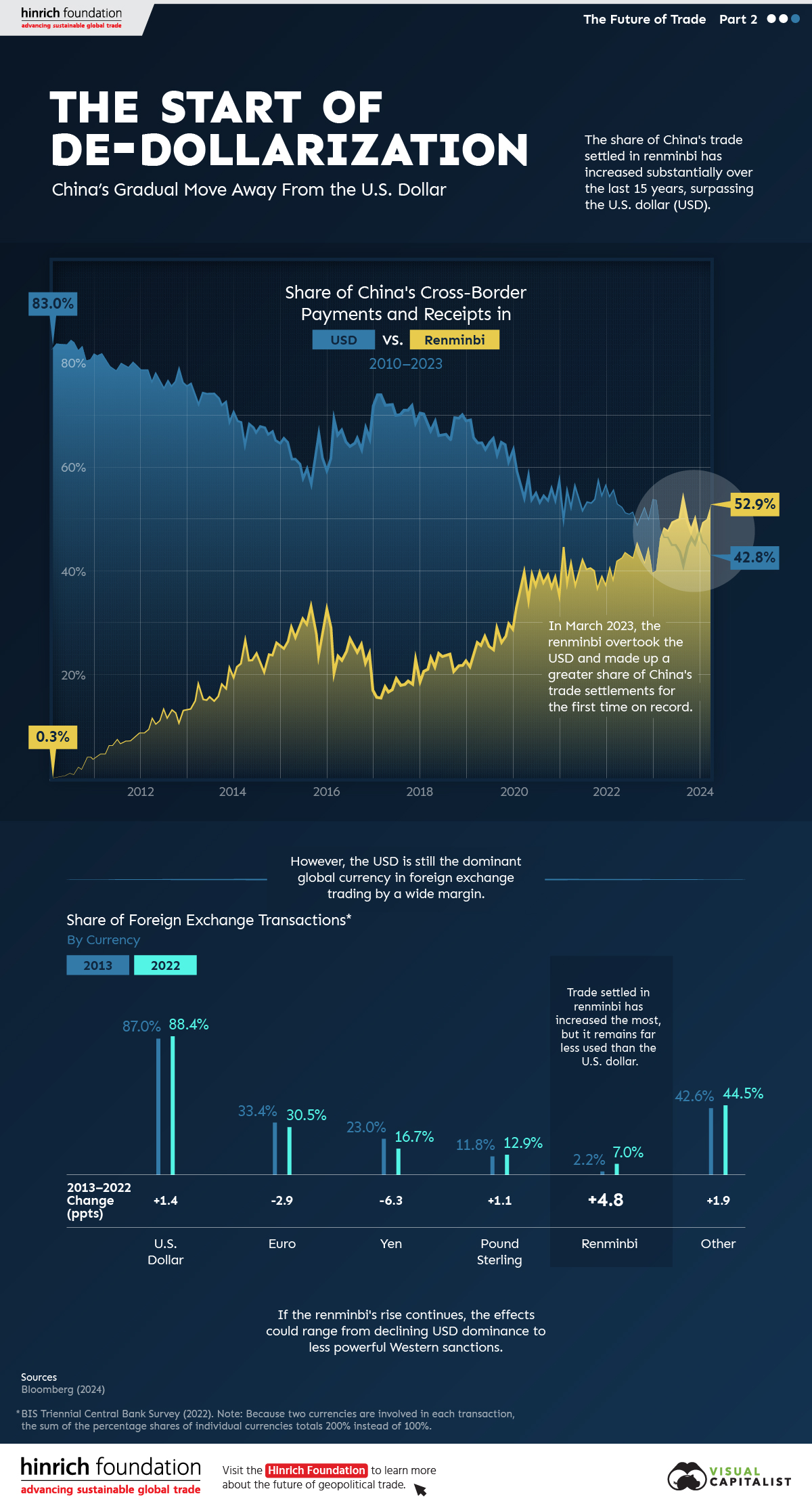Politics
Mapped: Which Countries Still Have a Monarchy?
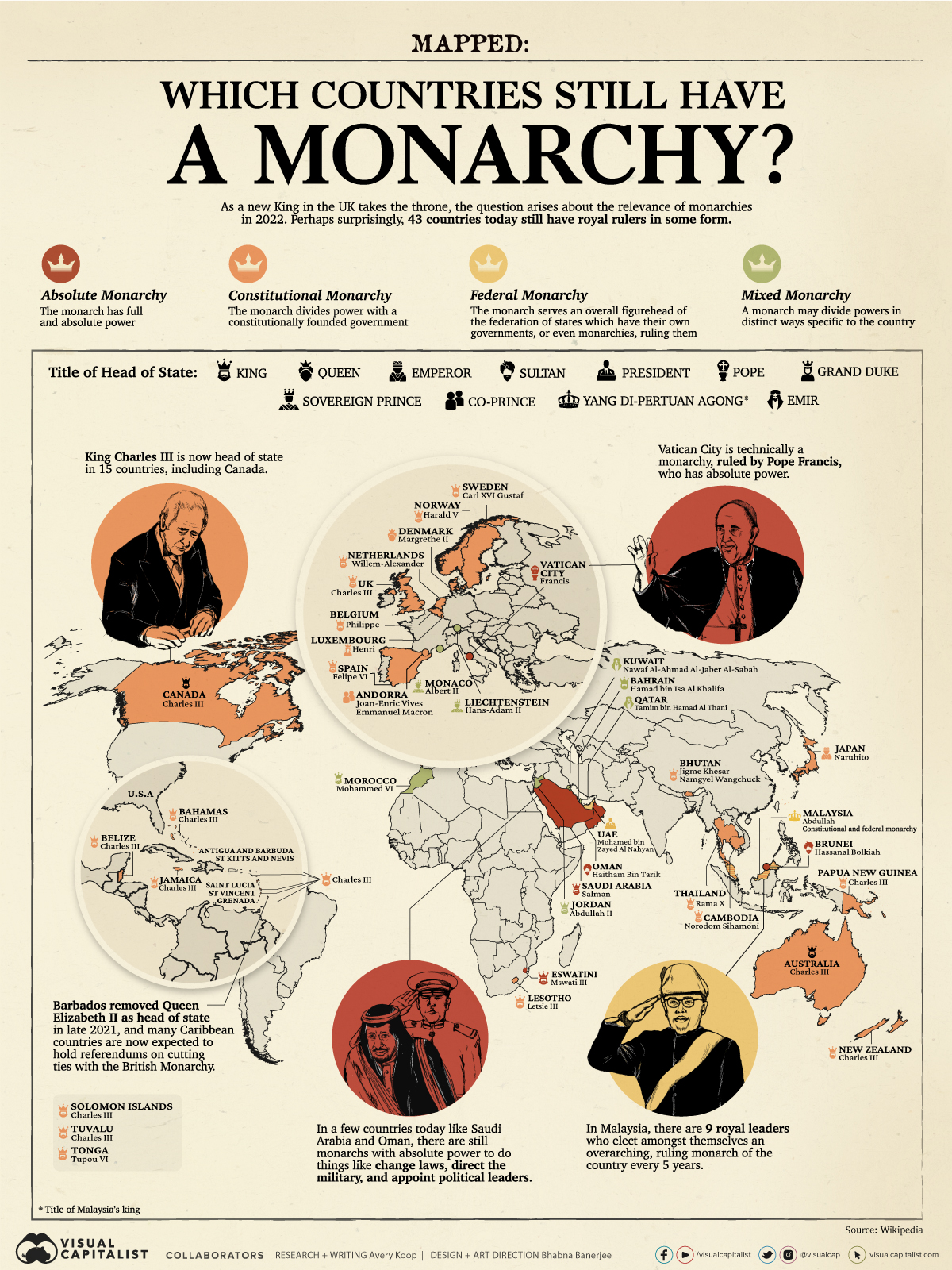
Mapped: Which Countries Still Have a Monarchy?
In the wake of Queen Elizabeth II’s death, the question of monarchy is brought sharply into focus.
However, a surprising number of countries have ruling monarchs, and in this visual we break down the kinds of royal leadership across the 43 countries that still have them.
Types of Monarchies
A monarch in the simplest sense is a country’s king, queen, emir, or sultan, and so on. But before diving in, it’s important to break down the distinctions between the types of monarchies that exist today. Generally, there are four kinds:
① Constitutional Monarchy
The monarch divides power with a constitutionally founded government. In this situation, the monarch, while having ceremonial duties and certain responsibilities, does not have any political power. For example, the UK’s monarch must sign all laws to make them official, but has no power to change or reject new laws.
Here are some examples of countries with constitutional monarchies:
🇯🇵 Japan
🇬🇧 United Kingdom
🇩🇰 Denmark
② Absolute Monarchy
The monarch has full and absolute political power. They can amend, reject, or create laws, represent the country’s interests abroad, appoint political leaders, and so on.
Here are some examples of countries with absolute monarchies:
🇸🇿 Eswatini
🇸🇦 Saudi Arabia
🇻🇦 Vatican City
③ Federal Monarchy
The monarch serves an overall figurehead of the federation of states which have their own governments, or even monarchies, ruling them.
Here are some examples of countries with federal monarchies:
🇦🇪 UAE
🇲🇾 Malaysia
Malaysia is a unique form of federal monarchy. Every five years, each state’s royal leaders choose amongst themselves who will be the monarch, or the Yang di-Pertuan Agong, of Malaysia and the respective states. Furthermore, the monarchy is also constitutional, allowing a democratically elected body to govern.
④ Mixed Monarchy
This is a situation wherein an absolute monarch may divide powers in distinct ways specific to the country.
Here are some examples of countries with mixed monarchies:
🇯🇴 Jordan
🇱🇮 Liechtenstein
🇲🇦 Morocco
Interestingly, Liechtenstein is the only European monarchy that still practises strict agnatic primogeniture. Under agnatic primogeniture, the degree of kinship is determined by tracing descent from the nearest common ancestor through male ancestors.
Kings, Queens, Emperors, and Sultans Around the Globe
Now let’s break down the different monarchies country by country:
| Country | Type of Monarchy | Title of Head of State | Monarch | Title of Head of Government |
|---|---|---|---|---|
| 🇦🇩 Andorra | Constitutional | Co-Princes | Joan-Enric Vives, Emmanuel Macron | Prime Minister |
| 🇦🇬 Antigua and Barbuda | Constitutional | King | Charles III | Prime Minister |
| 🇦🇺 Australia | Constitutional | King | Charles III | Prime Minister |
| 🇧🇭 Bahrain | Mixed | King | Hamad bin Isa Al Khalifa | Prime Minister |
| 🇧🇪 Belgium | Constitutional | King | Philippe | Prime Minister |
| 🇧🇿 Belize | Constitutional | King | Charles III | Prime Minister |
| 🇧🇹 Bhutan | Constitutional | King | Jigme Khesar Namgyel Wangchuck | Prime Minister |
| 🇧🇳 Brunei Darussalam | Absolute | Sultan | Hassanal Bolkiah | Sultan |
| 🇰🇭 Cambodia | Constitutional | King | Norodom Sihamoni | Prime Minister |
| 🇨🇦 Canada | Constitutional | King | Charles III | Prime Minister |
| 🇩🇰 Denmark | Constitutional | Queen | Margrethe II | Prime Minister |
| 🇸🇿 Eswatini | Absolute | King | Mswati III | Prime Minister |
| 🇬🇩 Grenada | Constitutional | King | Charles III | Prime Minister |
| 🇯🇲 Jamaica | Constitutional | King | Charles III | Prime Minister |
| 🇯🇵 Japan | Constitutional | Emperor | Naruhito | Prime Minister |
| 🇯🇴 Jordan | Mixed | King | Abdullah II | Prime Minister |
| 🇰🇼 Kuwait | Mixed | Emir | Nawaf Al-Ahmad Al-Jaber Al-Sabah | Prime Minister |
| 🇱🇸 Lesotho | Constitutional | King | Letsie III | Prime Minister |
| 🇱🇮 Liechtenstein | Mixed | Sovereign Prince | Hans-Adam II | Prime Minister |
| 🇱🇺 Luxembourg | Constitutional | Grand Duke | Henri | Prime Minister |
| 🇲🇾 Malaysia | Constitutional & Federal | Yang di-Pertuan Agong | Abdullah | Prime Minister |
| 🇲🇨 Monaco | Mixed | Sovereign Prince | Albert II | Minister of State |
| 🇲🇦 Morocco | Mixed | King | Mohammed VI | Prime Minister |
| 🇳🇱 Netherlands | Constitutional | King | Willem-Alexander | Prime Minister |
| 🇳🇿 New Zealand | Constitutional | King | Charles III | Prime Minister |
| 🇳🇴 Norway | Constitutional | King | Harald V | Prime Minister |
| 🇴🇲 Oman | Absolute | Sultan | Haitham bin Tarik | Sultan |
| 🇵🇬 Papua New Guinea | Constitutional | King | Charles III | Prime Minister |
| 🇶🇦 Qatar | Mixed | Emir | Tamim bin Hamad Al Thani | Prime Minister |
| 🇰🇳 Saint Kitts and Nevis | Constitutional | King | Charles III | Prime Minister |
| 🇱🇨 Saint Lucia | Constitutional | King | Charles III | Prime Minister |
| 🇻🇨 Saint Vincent and the Grenadines | Constitutional | King | Charles III | Prime Minister |
| 🇸🇦 Saudi Arabia | Absolute | King | Salman | Prime Minister |
| 🇸🇧 Solomon Islands | Constitutional | King | Charles III | Prime Minister |
| 🇪🇸 Spain | Constitutional | King | Felipe VI | President of the Government |
| 🇸🇪 Sweden | Constitutional | King | Carl XVI Gustaf | Prime Minister |
| 🇹🇭 Thailand | Constitutional | King | Rama X | Prime Minister |
| 🇧🇸 The Bahamas | Constitutional | King | Charles III | Prime Minister |
| 🇹🇴 Tonga | Constitutional | King | Tupou VI | Prime Minister |
| 🇹🇻 Tuvalu | Constitutional | King | Charles III | Prime Minister |
| 🇦🇪 UAE | Federal | President | Mohamed bin Zayed Al Nahyan | Prime Minister |
| 🇬🇧 UK | Constitutional | King | Charles III | Prime Minister |
| 🇻🇦 Vatican City | Absolute | Pope | Francis | President of the Pontifical Commission |
Constitutional monarchies are undoubtedly the most popular form of royal leadership in the modern era, making up close to 70% of all monarchies. This situation allows for democratically elected governments to rule the country, while the monarch performs ceremonial duties.
Most monarchs are hereditary, inheriting their position by luck of their birth, but interestingly, French president, Emmanuel Macron, technically serves as a Co-Prince of Andorra.
Another unique case is the Vatican’s Pope Francis, who has absolute power in the small independent city—he gained his role thanks to an election process known as a papal conclave.
The Role of Monarchies
One of the most notable and famous ruling monarchies is the United Kingdom’s House of Windsor—also known as Queen Elizabeth II’s family. King Charles III has now ascended to the country’s throne, making him head of state in 15 nations total, including Canada, Australia, and New Zealand.
Many see the benefit in having a stable and consistent form of tradition and decorum at the country’s head of state.
“The Crown is an integral part of the institution of Parliament. The Queen [now King] plays a constitutional role in opening and dissolving Parliament and approving Bills before they become law.” – British Parliament
Japan’s royal family has been a prime example of stability, having reigned in the country for more than 2,600 years under the same hereditary line.
Critiques and the Future of Monarchy
Some claim, however, that there is no function of monarchy in the modern day, and complaints of monarchies’ immense wealth and power are rampant.
For example, according to the Dutch government, King Willem-Alexander’s budget for 2022, funded by the state and thus, taxpayers, comes out to more than €48 million.
Beyond tax dollars, with absolute monarchies there is typically a lack of political freedoms and certain rights. Saudi Arabia, for example, has no national elections. Rather its king, Salman bin Abdulaziz Al Saud, stays in power for life, appoints the cabinet himself, and passes laws by royal decree.
The death of Queen Elizabeth, though, may bring about change though for many of the world’s royally-governed. Since Barbados’ removal of her as head of state in 2021, six other Caribbean nations have expressed the desire to do the same, namely:
🇧🇿 Belize
🇧🇸 The Bahamas
🇯🇲 Jamaica
🇬🇩 Grenada
🇦🇬 Antigua and Barbuda
🇰🇳 St. Kitts and Nevis
The future of monarchy in the 21st century is certainly not a guarantee.
Politics
The Start of De-Dollarization: China’s Gradual Move Away from the USD
The de-dollarization of China’s trade settlements has begun. What patterns do we see in USD and RMB use within China and globally?
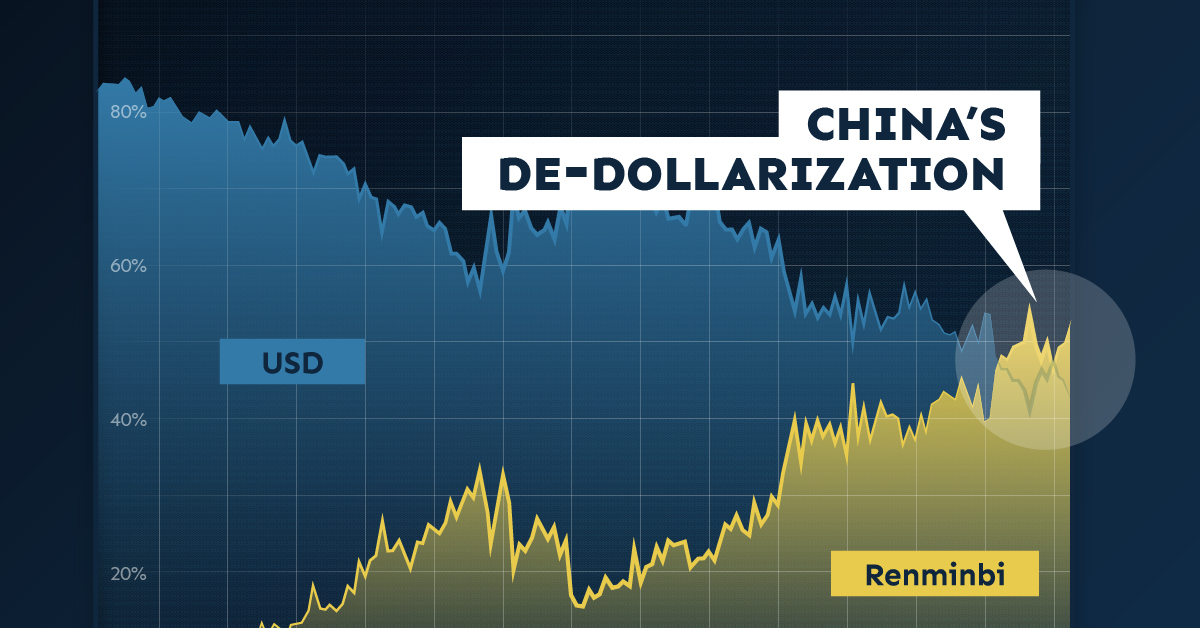
The Start of De-Dollarization: China’s Move Away from the USD
Since 2010, the majority of China’s cross-border payments, like those of many countries, have been settled in U.S. dollars (USD). As of the first quarter of 2023, that’s no longer the case.
This graphic from the Hinrich Foundation, the second in a three-part series covering the future of trade, provides visual context to the growing use of the Chinese renminbi (RMB) in payments both domestically and globally.
The De-Dollarization of China’s Cross-Border Transactions
This analysis uses Bloomberg data on the share of China’s payments and receipts in RMB, USD, and other currencies from 2010 to 2024.
In the first few months of 2010, settlements in local currency accounted for less than 1.0% of China’s cross-border payments, compared to approximately 83.0% in USD.
China has since closed that gap. In March 2023, the share of the RMB in China’s settlements surpassed the USD for the first time.
| Date | Renminbi | U.S. Dollar | Other |
|---|---|---|---|
| March 2010 | 0.3% | 84.3% | 15.4% |
| March 2011 | 4.8% | 81.3% | 13.9% |
| March 2012 | 11.5% | 77.1% | 11.5% |
| March 2013 | 18.1% | 72.7% | 9.2% |
| March 2014 | 26.6% | 64.8% | 8.6% |
| March 2015 | 29.0% | 61.9% | 9.0% |
| March 2016 | 23.6% | 66.7% | 9.7% |
| March 2017 | 17.6% | 72.5% | 9.9% |
| March 2018 | 23.2% | 67.4% | 9.4% |
| March 2019 | 26.2% | 65.1% | 8.7% |
| March 2020 | 39.3% | 54.4% | 6.3% |
| March 2021 | 41.7% | 52.6% | 5.6% |
| March 2022 | 42.1% | 53.3% | 4.7% |
| March 2023 | 48.4% | 46.7% | 4.9% |
| March 2024 | 52.9% | 42.8% | 4.3% |
Source: Bloomberg (2024)
Since then, the de-dollarization in Chinese international settlements has continued.
As of March 2024, over half (52.9%) of Chinese payments were settled in RMB while 42.8% were settled in USD. This is double the share from five years previous. According to Goldman Sachs, foreigners’ increased willingness to trade assets denominated in RMB significantly contributed to de-dollarization in favor of China’s currency. Also, early last year, Brazil and Argentina announced that they would begin allowing trade settlements in RMB.
Most Popular Currencies in Foreign Exchange (FX) Transactions
Globally, analysis from the Bank for International Settlements reveals that, in 2022, the USD remained the most-used currency for FX settlements. The euro and the Japanese yen came in second and third, respectively.
| Currency | 2013 | 2022 | Change (pp) |
|---|---|---|---|
| U.S. Dollar | 87.0% | 88.5% | +1.5 |
| Euro | 33.4% | 30.5% | -2.9 |
| Yen | 23.0% | 16.7% | -6.3 |
| Pound Sterling | 11.8% | 12.9% | +1.1 |
| Renminbi | 2.2% | 7.0% | +4.8 |
| Other | 42.6% | 44.4% | +1.8 |
| Total | 200.0% | 200.0% |
Source: BIS Triennial Central Bank Survey (2022). Because two currencies are involved in each transaction, the sum of the percentage shares of individual currencies totals 200% instead of 100%.
The Chinese renminbi, though accounting for a relatively small share of FX transactions, gained the most ground over the last decade. Meanwhile, the euro and the yen saw decreases in use.
The Future of De-Dollarization
If the RMB’s global rise continues, the stranglehold of the USD on international trade could diminish over time.
The impacts of declining dollar dominance are complex and uncertain, but they could range from the underperformance of U.S. financial assets to diminished power of Western sanctions.
However, though the prevalence of RMB in international payments could rise, a complete de-dollarization of the world economy in the near- or medium-term is unlikely. China’s strict capital controls that limit the availability of RMB outside the country, and the nation’s sputtering economic growth, are key reasons contributing to this.
The third piece in this series will explore Russia’s shifting trading patterns following its invasion of Ukraine.

Visit the Hinrich Foundation to learn more about the future of geopolitical trade

-

 Politics6 days ago
Politics6 days agoWhich Countries Have the Most Economic Influence in Southeast Asia?
One country dominates this survey of who has the most economic influence in the region.
-
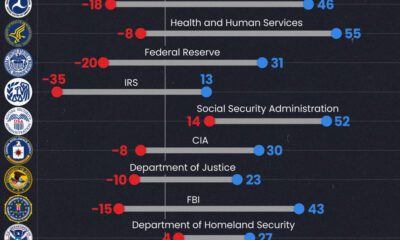
 Politics1 week ago
Politics1 week agoCharted: How Democrats and Republicans View Government Agencies
Predictably, results diverge when both Democrats and Republicans are asked to rate key government agencies in the United States.
-

 Misc2 weeks ago
Misc2 weeks agoVisualized: Aircraft Carriers by Country
The U.S. controls 40% of global aircraft carrier fleet.
-

 Politics2 weeks ago
Politics2 weeks agoCharted: How Americans Feel About Federal Government Agencies
Fourteen of 16 federal government agencies garnered more favorable responses than unfavorable ones. But what were the outliers?
-

 Politics3 weeks ago
Politics3 weeks agoCharted: What Southeast Asia Thinks About China & the U.S.
A significant share of respondents from an ASEAN-focused survey are not happy about rising American and Chinese influence in the region.
-

 Politics3 weeks ago
Politics3 weeks agoCharted: Trust in Government Institutions by G7 Countries
How much do you trust the government and its various institutions? We look at data for G7 countries for the time period of 2006-2023.
-
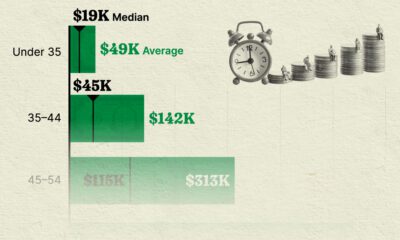
 Money1 week ago
Money1 week agoVisualizing America’s Average Retirement Savings, by Age
-

 Economy2 weeks ago
Economy2 weeks agoVisualizing the Tax Burden of Every U.S. State
-

 Automotive2 weeks ago
Automotive2 weeks agoHow People Get Around in America, Europe, and Asia
-

 Maps2 weeks ago
Maps2 weeks agoMapped: Southeast Asia’s GDP Per Capita, by Country
-

 Maps2 weeks ago
Maps2 weeks agoMapped: U.S. Immigrants by Region
-

 Healthcare2 weeks ago
Healthcare2 weeks agoWhich Countries Have the Highest Infant Mortality Rates?
-

 Politics2 weeks ago
Politics2 weeks agoCharted: How Americans Feel About Federal Government Agencies
-

 Mining2 weeks ago
Mining2 weeks agoVisualizing Copper Production by Country in 2023





